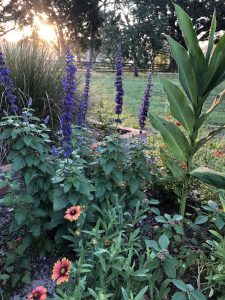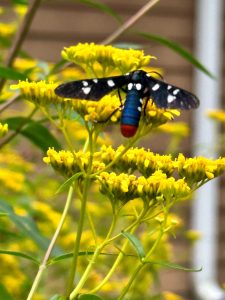Pollinator gardening is becoming more popular across Florida and the United States, and for good reason! Recent studies have indicated that small microhabitats incorporated within home landscapes have extensive benefits for pollinators and can even sustain their populations (Silvert et al., 2023). These gardens not only provide beautiful, diversified landscapes, but also increases habitat space for many wildlife species who need it due to factors like deforestation and urban development. As popularity for pollinator-friendly gardening increases, garden centers are taking advantage of this newfound demand and using advertising methods to attract such consumers, but are those so-called pollinator-friendly plants truly pollinator-safe?

The Problem
Though interest is growing in pollinator gardening, it has still not taken over the higher demand for beautiful blooming landscape plants that are free from insect defoliation or even presence. A common dilemma that gardeners regularly run into is mistakenly purchasing pollinator plant matter that has been treated with pesticides. This includes both pollinator plants and seeds. When these plants are incorporated into the home landscape, or when pesticide-treated seeds germinate in the garden, many pollinators feed from them and die. It’s not long before you start noticing a decline in pollinator presence within the landscape and realizing that what you purchased may not have been intended for pollinator use after all.
The advertisement is not necessarily wrong. In many cases these plants and seeds are considered pollinator-friendly or might even be known as a pollinator host plant, but when they’ve been treated with pesticides intended to kill or deter insects, they are no longer safe for pollinators. Take Tropical Milkweed (Asclepias currassavica) for example, often you will find this plant in nurseries in a section that is advertised as Butterfly or Pollinator Plants, because they are. Milkweed (Asclepias spp.) is the larval host plant for monarch butterflies. The primary consumers, however, are not purchasing milkweed or other plants for pollinators, but instead for bright-colored blooming flowers for the home landscape, free from insect damage.
“The primary consumers, however, are not purchasing milkweed or other plants for pollinators, but instead for bright-colored blooming flowers for the home landscape, free from insect damage.”
Neonicotinoid pesticides are some of the most commonly used chemicals for controlling insects in the ornamental plant industry. Once they are applied, they are then absorbed into the plant tissue and are then invisible to both humans and wildlife. Studies have found neonicotinoids persist in plant foliage for several months, and more than a year in woody plants. For the nursery industry, this not only allows them to produce high-quality, sellable product, but also ensures the plant performs well in the long-term, which builds a great reputation for the nursery.
It’s important to note that in many cases there are state guidelines that require nursery stock to be free of insects. Some states even mandate the use of pesticides on nursery stock. Therefore, it is not necessarily that nurseries are absent-minded from protecting pollinators, it’s that they are often limited on what they can do or use, and they must do something to ensure their product performs as expected by the consumer.
A Potential Solution
So, how can you make sure that what you are purchasing is safe for your landscape? The truth is, it’s not always going to be simple, but you can start by speaking with the nursery staff and asking them the following questions:
1. Where can I find pollinator attracting plants in your nursery?
This may sound simple, but there’s a lot of power behind this question. By asking this, it not only guides you to their location, but more importantly it signals to the nursery there is a demand for this product. Imagine multiple people asking this same question each day.
2. Do you have native plant species?
When it comes to attracting pollinators, native plants generally outperform non-native varieties. Native plants also utilize less water, generally re-germinate and reseed on their own, and establish themselves easier than non-native species. Additionally, they attract a diversity of wildlife species, not just insect pollinators. Keep in mind that not all pollinator plants are those that are currently flowering. There are many plants that rarely flower, and yet are host plants for a variety of pollinator species. For example, Live Oak (Quercus virginiana), is a Florida native tree that is a host plant to more than 345 moth and butterfly species, and it only flowers for a brief period during the spring. In addition, such trees provide shelter and habitat for many pollinator and wildlife species, not just insects. As with the previous question, asking about native plants conveys the consumers interest in plant selection.

3. Have these plants and/or seeds been treated with pesticides?
You’re likely going to find that many large box-store garden centers are not going to have the answer to this question. Most of the time their nursery stock is outsourced from wholesale nurseries, and therefore receiving a solid answer to this question is not always likely. For this reason, many pollinator gardeners prefer to buy from local nurseries who have either grown or produced these products on their own and are likely be able to answer this question, or are in direct contact with the nursery that can provide a clear answer.
Regardless of where you go, if the answer to this question is unknown, use your best judgement. Look for signs of insect activity, such as chewed leaves, caterpillar frass (droppings), or actual insect presence. This likely is an indicator the plant is safe. If none of these are present and there’s no clear answer of whether it’s been treated with pesticides, you may want to reconsider making the purchase. Think of it this way, if there’s a large table full of brightly colored flowers and yet you see no insect activity, that’s a major red flag.
In addition to asking these questions, do your own research. Don’t be afraid to contact the wholesale nurseries that stock box-stores to get information. Contact your Extension office or local Native Plant Society chapter and ask them for a list of reputable nurseries. Visit your local nurseries and establish a working relationship with the supervisors or owners, and share your concerns with them. When purchasing seeds, use reputable seed companies with non-treated seeds. By taking these extra steps, you’re ensuring the efforts of your labor are indeed helping the pollinators.
In Summary
As pollinator-friendly gardening becomes more popular, these strategies will help you to ensure your plant selections are safe for your pollinators and other surrounding wildlife. Additionally, it’s important that we remember consumer demand is what drives the market, and it is our voice that has the power to transform such practices. Ask questions, share your concerns, and protect our pollinators by building the demand for true pollinator-friendly plant products.
 7
7
